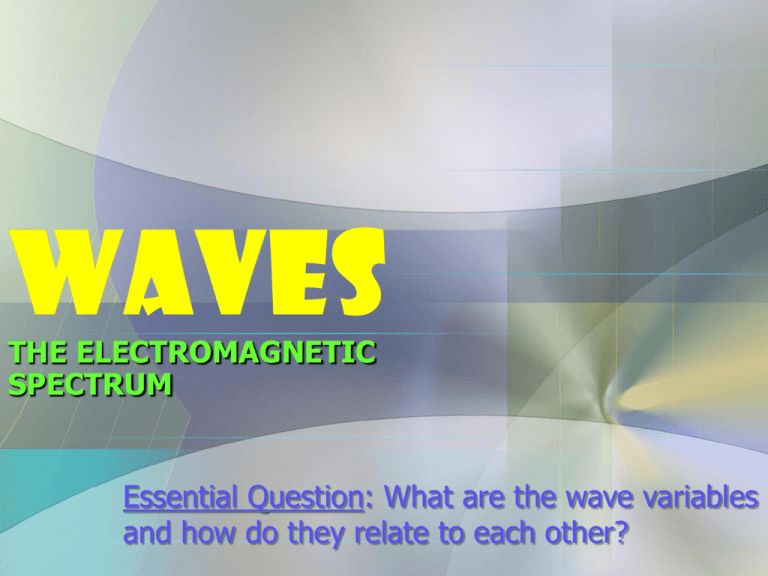WAVES
advertisement

WAVES THE ELECTROMAGNETIC SPECTRUM Essential Question: What are the wave variables and how do they relate to each other? O Y G B I V 10-14 10-12 10-10 Gamma rays R Wavelength (λ) in meters Visible light 10-8 10-6 Ultraviolet 10-4 1020 1018 100 Infrared 102 Radio TV, FM 1016 1014 1012 1010 108 AM 106 Frequency (f) in Hertz High Energy 104 Microwave X rays 1022 10-2 Low Energy 104 Waves are the result of a vibration traveling from one location to another. Waves are a method that enrgy uses to travel from one location to another velocity Wave Types of Waves • Longitudinal or compression – vibrate parallel to velocity. ex. Sound • Transverse – vibrations perpendicular to velocity. ex. Light and water waves Frequency (f) in Hertz Wavelength (λ) in meters Vertical displacement Crest λ (Waves per Second) Amplitude 1 Hertz 1 second Trough 2 Hertz f 3 Hertz Period and Frequency of Vibrations • period – time (seconds) it takes for 1 vibration (wave) to occur. Unit: s • frequency – number of vibrations (waves) in a second Unit: Hz or s-1 • f = 1/p AND p = 1/f 10Hz has a period of 1/10th of a second Period = 1/10 or 0.1 1 second .1s .2s .3s .4s .5s .6s .7s .8s .9s 1s f = 10 Hz Electromagnetic Spectrum Wave Uses Relative Wavelength What type of wave is it? Use EM spectrum 1. λ = 2.90 x 10-8 m 2. f = 6.35 x 10 Hz 5. f = 1.52 x 1022 Hz 6. f = 3.99 x 108 Hz 3. λ = 7.01 x 10-6 m 4. λ = 9.40 x 10-14 m 7. λ = 8.34 x 10-10 m 8. f = 2.76 x 1010 Hz Calculating frequency, wavelength, period and velocity Symbol Wavelength λ (Lambda) Unit Equation Meters (m) λ = v/f f = v/λ Frequency f Period p s 1/f velocity of light v* Meters per second (m/s) v=fλ v = velocity c Meters per second (m/s) c=fλ *Speed of light (3.00 x10 8) Hertz (Hz, s-1) f = 1/p 1. Draw continuous Y axis 4 sq from left side all the way down 2. Calculate amplitude sq. + 1. Count down from the top this many squares and draw your x axis all the way across 3. Dots represent wavelength, dashes represent half a wavelength: calculate # of sq. for wavelength and make your dots (number of dots is determined by # of vibrations) 4. In between each dot along your x axis make your dashes 5. Calculate # of sq. for amplitude. Make a dot in between dashes and dots up the correct number of dots. Alternate this for crest and trough 6. Connect the dots to form your wave. Speed of Light Speed of light (c) in a vacuum = 8 3.00 x10 meters per second (m/s) In any other medium you have to calculate velocity v=fλ Vacuum Water How fast is the speed of light? Going around the world 7.5 times a second What is the wavelength? What is the frequency? What is the speed of the wave? 1) The wavelength of an x-ray is 4.32 x 10-11 m. What is its frequency? 3.00x108 m/s 18 Hz f = c/λ = = 6.94 x10 4.32x10-11 m 2) Ultraviolet radiation from the sun has a frequency of 2.49 x 1016 Hz. What is its wavelength? 3.00x108 m/s -8 m = 1.20x10 λ = c/f = 2.49x1016 s-1 3) An infrared ray has a frequency of 1.01E10 Hz and a wavelength of 2.95 x 10-2 m. What is the speed of the wave? 1.01x1010 Hz x 2.95x10-2 = 2.98x108 m/s Radio Stations Radio stations transmit their signal in megahertz (MHz) 1 megahertz = ? Hertz 106 98.5 MHz 1 x 106 Hz 1 MHz = 9.85x 107 Hz Radio Station’s Wavelength What is the wavelength of these radio stations? 1) 2) 97.9 MHz (you have to convert to Hz first) 9.79 x 107 Hz λ = c/f 3.06 m 104.5 MHz 8 1.045 x10 Hz λ = c/f 3) 1.053 105.3 x108 HzMHz λ = c/f 2.87 m 2.85 m Interference • Interference occurs when 2 waves occupy the same space at the same time. • It can be “destructive” or “constructive”, depending if the waves are “in phase” or “out of phase”. Interference • Destructive + = • Constructive + = v=fλ In a vacuum v = (c) speed of light In any other medium you have to calculate velocity Faster = f or ↓ λ Slower = ↓f or λ Color Wavelengths Color λ (m) R O Y G B I V 7.00E-7 6.50E-7 6.00E-7 5.50E-7 4.70E-7 4.30E-7 4.00E-7 Baaaaaa a! Lambda! A B C D 2 Hertz λ f 3 Hertz 1 sec 1 sec 1 sec 1 sec Period (time 1 swing) Title Period (time 1 swing) s 3 Title No breaks! 0 String length (m)





